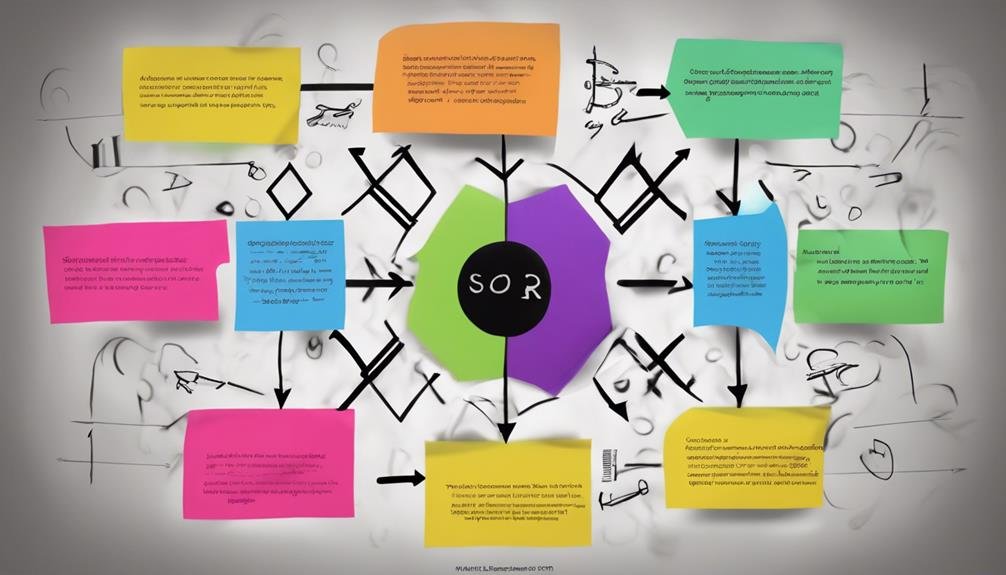Strategies for Enhancing Reading Comprehension in Early Learners
Have you ever wondered how to help young learners grasp the meaning behind the words they encounter? Understanding the strategies that can aid in enhancing early learners' comprehension skills is essential for their overall development.
By incorporating specific techniques and approaches, you can create a solid foundation for their future academic success.
Let's explore some effective methods that can make a significant difference in how young minds process information and make sense of the world around them.
Key Takeaways
- Utilize word association and context clues for vocabulary development and independent word deciphering.
- Engage in active reading strategies like questioning, relating text to experiences, and creating mental images.
- Implement reading comprehension techniques such as mind mapping, concept mapping, and visualizing information.
- Foster interactive reading approaches through dialogues, read-alongs, and character voices to enhance comprehension and engagement.
Building Vocabulary Skills

To improve reading comprehension in early learners, focus on expanding their vocabulary through engaging activities and exposure to a variety of words in context. Word association is a powerful tool that can help young readers connect new words to familiar ones, making it easier for them to remember and understand. By linking new vocabulary to concepts they already know, children can enhance their comprehension skills and retain new words more effectively.
Additionally, teaching children to use context clues can greatly aid in deciphering the meaning of unfamiliar words. Encouraging them to look at the surrounding text for hints about the word's definition can empower them to independently tackle challenging vocabulary. Through activities like identifying context clues in stories or passages, learners can develop the skills needed to infer meanings and enhance their overall reading comprehension.
Incorporating strategies that focus on word association and context clues can lay a solid foundation for expanding early learners' vocabulary and improving their reading comprehension abilities. By engaging with words in meaningful contexts, children can develop a deeper understanding of language and enhance their overall reading experience.
Encouraging Active Reading
Encourage young readers to actively engage with texts by implementing strategies that promote interaction and critical thinking while reading. Interactive participation is key to enhancing reading comprehension in early learners. By fostering a habit of active reading, children can develop a deeper understanding of the text and improve their critical thinking skills. Here are some effective strategies to encourage active reading:
| Strategies for Active Reading | Description |
|---|---|
| Ask Questions | Encourage children to ask questions about the text while reading to stimulate critical thinking. |
| Make Connections | Prompt young readers to relate the text to their own experiences or other books they have read. |
| Visualize | Encourage children to create mental images of the story to enhance comprehension. |
| Summarize | Have kids summarize what they've read in their own words to ensure understanding. |
These strategies promote engagement and critical analysis, leading to improved reading comprehension skills in early learners.
Utilizing Graphic Organizers

By incorporating graphic organizers, you can visually organize information from texts, facilitating a deeper understanding of the content and enhancing reading comprehension skills. When young readers engage with graphic organizers, they can benefit in various ways:
- Mind Mapping: Encourages brainstorming and helps in connecting ideas in a non-linear format. It allows you to see the relationships between different concepts more clearly, aiding in comprehension.
- Concept Mapping: Involves visualizing information by creating a hierarchical structure of concepts. This method helps in organizing information into categories and subcategories, making it easier to grasp complex ideas.
- Visualizing: Through the use of diagrams, charts, or graphs, visualizing information can enhance comprehension by providing a visual representation of textual content.
Research suggests that utilizing graphic organizers can significantly improve reading comprehension among young learners. By incorporating these techniques into reading activities, you can effectively support their comprehension skills and foster a deeper connection with the text.
Implementing Reading Aloud Sessions
Implementing Reading Aloud Sessions can enhance young learners' comprehension skills and foster a deeper connection with the text through engaging auditory experiences. When conducting these sessions, focus on interactive dialogues and engaging storytelling to captivate the audience. Interactive read-alongs and expressive reading can greatly impact a child's understanding and enjoyment of the material. By incorporating different voices for characters or using props to bring the story to life, you create a more immersive and memorable experience for the young listeners.
Below is a table highlighting the benefits of Implementing Reading Aloud Sessions:
| Benefits of Reading Aloud Sessions |
|---|
| Enhances comprehension skills |
| Fosters a deeper connection with the text |
| Encourages interactive dialogues |
Engaging young learners in interactive read-alongs and expressive reading sessions not only improves their comprehension but also instills a love for reading. These sessions create a shared experience between the reader and the listeners, making the learning process enjoyable and effective.
Engaging in Predictive Reading

How can early learners actively engage in predictive reading to enhance their comprehension skills and critical thinking abilities?
Engaging in predictive reading involves utilizing strategies that encourage learners to make predictions based on the text and participate in interactive discussions to deepen their understanding. Here are three key ways to enhance predictive reading skills:
- Encourage Making Predictions: Prompt early learners to make predictions about what they think will happen next in the story based on the information presented. This can be done individually or in groups to stimulate critical thinking.
- Discuss Predictions: Engage in interactive discussions where learners share their predictions with each other. Encourage them to provide reasons for their predictions, fostering a deeper analysis of the text.
- Connect Predictions to Text: After reading, revisit the predictions made and analyze whether they were accurate. This reflection helps learners understand the text better and improve their comprehension skills.
Promoting Discussion Groups
Promoting discussion groups among early learners can greatly enhance their reading comprehension and critical thinking skills through active engagement and collaborative analysis. Collaborative dialogues within these groups allow children to share their interpretations of the text, listen to their peers' perspectives, and construct meaning together. Peer interactions provide opportunities for students to ask questions, clarify uncertainties, and deepen their understanding of the reading material.
Engaging in these discussions helps young learners develop higher-order thinking skills as they learn to evaluate different viewpoints, articulate their thoughts, and build on each other's ideas. Through this process, children not only improve their comprehension but also enhance their ability to think critically about the text and make connections to their own experiences.
Incorporating Retelling Activities

Incorporating retelling activities into early learners' reading routines enhances their comprehension and memory retention of the material. Retelling allows children to engage with the text on a deeper level, improving their understanding of story elements and overall literacy skills.
- Story Sequencing: By retelling a story in their own words, children learn to identify the beginning, middle, and end of a narrative, enhancing their grasp of chronological order.
- Character Analysis: Retelling encourages kids to explore into characters' motives, feelings, and actions, fostering empathy and critical thinking.
- Plot Summary: Summarizing a story aids in recognizing key events and understanding the flow of the plot, reinforcing comprehension skills.
Through retelling activities, young learners not only sharpen their storytelling abilities but also gain insights into themes and messages conveyed in the text. This interactive approach to reading nurtures a love for stories and boosts overall reading comprehension, setting a strong foundation for future academic success.
Using Visual Aids Effectively
To enhance early learners' reading comprehension effectively, utilizing visual aids can greatly amplify their understanding and engagement with the material. Visual aids brainstorming involves coming up with creative ways to represent information visually, such as using charts, diagrams, or flashcards. These tools can help young readers make connections between words and images, aiding in memory retention and comprehension.
Interactive images analysis is another powerful method. By incorporating interactive elements like clickable hotspots or pop-up definitions, children can actively engage with the material, promoting a deeper understanding of the text. Research shows that visual aids not only enhance comprehension but also make learning more enjoyable for young readers.
When selecting visual aids, consider the age and interests of the learners to ensure relevance and engagement. By incorporating a variety of visual tools and techniques, educators can cater to different learning styles, making the reading experience more enriching and effective for early learners.
Introducing Questioning Techniques

Engage early learners effectively by implementing strategic questioning techniques that encourage critical thinking and deeper understanding of the material. Questioning techniques play an essential role in fostering interactive discussions and promoting critical thinking skills among young readers.
By incorporating guided inquiries into your teaching approach, you can enhance comprehension and encourage students to explore further into the text. Here are three key strategies to help you introduce questioning techniques effectively:
- Open-Ended Questions: Encourage students to think critically by asking open-ended questions that require more than a simple yes or no answer.
- Socratic Questioning: Use the Socratic method to guide students through a series of questions that lead them to discover the meaning and implications of the text.
- Questioning Hierarchies: Help students develop a deeper understanding of the material by structuring questions in a hierarchical manner, starting from basic comprehension to higher-order thinking.
Expanding Background Knowledge
Building upon the foundation of questioning techniques, further enriching students' background knowledge can greatly enhance their reading comprehension skills and critical thinking abilities. By helping students make connections between what they already know and new information, educators can support schema building and concept extension. Here is a table outlining ways to expand students' background knowledge:
| Strategies for Expanding Background Knowledge |
|---|
| 1. Encourage students to relate new information to their own experiences. |
| 2. Use graphic organizers to visually represent connections between prior knowledge and new concepts. |
| 3. Integrate multimedia resources to provide diverse perspectives and enhance understanding. |
| 4. Promote discussions that allow students to share their insights and learn from each other. |
These strategies aim to deepen students' understanding by tapping into their prior knowledge and expanding on it. By fostering background connections and extending concepts, educators can help students become more engaged and proficient readers.
Providing Diverse Reading Materials

Diversifying the selection of reading materials plays an important role in fostering a complete and inclusive learning environment for early learners. Reading diversity exposes children to various cultures, experiences, and perspectives, enhancing their empathy and understanding of the world around them. Multicultural books help young readers see themselves reflected in stories and also introduce them to characters from different backgrounds, promoting a sense of belonging and respect for diversity.
- Cultural Representation: Including books that feature characters from diverse backgrounds allows children to connect with different cultures and traditions, expanding their worldview.
- Language Variety: Offering reading materials in various languages can help bilingual or multilingual learners feel valued and appreciated, fostering language development and cultural pride.
- Historical Context: Introducing books that explore historical events from different perspectives can deepen children's understanding of complex issues and encourage critical thinking skills.
Monitoring Progress and Adjusting Strategies
To effectively enhance reading comprehension in early learners, regularly monitoring their progress and adjusting instructional strategies is imperative for tailored and impactful learning experiences. Reflective assessment and providing individualized feedback are key components in ensuring that each child's specific needs are addressed. By observing how a student engages with different texts and materials, educators can gain valuable insights into their comprehension levels and areas that may need improvement.
| Monitoring Progress | Adjusting Strategies |
|---|---|
| Analyze reading fluency | Modify text complexity |
| Assess comprehension skills | Introduce new strategies |
| Track vocabulary expansion | Offer targeted interventions |
| Evaluate reading stamina | Incorporate diverse materials |
| Review reading response | Provide additional support |
Data-driven adjustments based on these assessments allow for targeted interventions that cater to the individual requirements of each learner. By regularly reviewing and adapting instructional methods, educators can create a dynamic learning environment that nurtures reading comprehension skills effectively.
Frequently Asked Questions
How Can Parents and Caregivers Support Reading Comprehension in Early Learners Outside of School Hours?
To support reading comprehension in early learners outside of school hours, engage in interactive storytelling. Lead parent book clubs, promote outdoor reading, and incorporate educational games. These activities foster a love for reading and improve comprehension skills.
Are There Any Specific Strategies for Helping Children With Learning Disabilities Improve Their Reading Comprehension Skills?
Improving reading comprehension in learners with disabilities requires individualized interventions for success. Assistive technology, multisensory approaches, and explicit instruction are key. Did you know that 35% of students with learning disabilities struggle with reading comprehension?
What Are Some Creative Ways to Make Reading Comprehension Activities More Engaging and Fun for Young Children?
To make reading comprehension activities engaging and fun for young children, try incorporating interactive storybooks, role-playing, and scavenger hunts. These creative strategies can enhance their comprehension skills while keeping them entertained and enthusiastic to learn.
How Can Technology Be Utilized to Enhance Reading Comprehension in Early Learners?
Utilize interactive apps, virtual tutoring, online games, and digital resources to enhance reading comprehension in early learners. These tools engage young minds, making learning enjoyable and effective while providing a modern approach to education.
Are There Any Research-Based Strategies or Evidence-Based Interventions That Have Been Proven to Be Especially Effective in Improving Reading Comprehension in Young Children?
To boost young readers' comprehension, try research-backed strategies. Evidence shows targeted interventions like explicit instruction and reciprocal teaching enhance reading skills. Embrace these approaches to see notable improvements in children's reading proficiency.
Conclusion
In the journey of nurturing young minds to become proficient readers, remember that building a strong foundation is key. Just like a gardener carefully tends to their seeds, you must cultivate vocabulary, encourage active reading, and provide a diverse range of materials.
By utilizing effective strategies and monitoring progress, you can help early learners blossom into confident and skilled readers. Keep watering and nurturing their reading skills, and watch them grow into flourishing readers.






